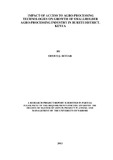| dc.description.abstract | Agriculture remains the lifeblood of many countries as exemplified by its dominance in a large number
of economies across the globe. However, primary agriculture alone can no longer provide reliable
livelihood. Thus, the pattern of economic growth in these countries has witnessed a gradual shift from
agriculture to industry. Agro-processing, which is the stimulant for this transformation from agriculture
to industry, is one of the sub-sectors now being focussed-on to provide additional income generating
opportunities to support the growing population particularly in the developing economies. Inspite of the
emerging importance of agro-processing in industrialization process its growth has been faced with the
constraints of access to agro-processing technologies, especially among smallholder agri-businesses.
Consequently high proportion of agricultural produce in developing countries is traded in raw form and
fails to compete favourably in both local and international markets resulting into exploitation and poor
returns. The objectives of the study were to: determine the extent to which manufacturing equipments
impact on growth of smallholder agro-processing industry; establish the impact of manufacturing skills
training on growth of smallholder agro-processing industry; examine the impact of access to automated
functions on growth of smallholder agro-processing industry; and evaluate the extent to which training
on managerial skills impacts on growth of smallholder agro-processing industry in Bureti District. The
study employed a cross-sectional descriptive research design in which main emphasis was on
quantitative data with limited use of qualitative data that helped to fill information gaps. The accessible
target population was all the 400 agro-processing/value-addition groups and individuals as well as all
the 22 technical experts offering agro-processing training and advisory services in Bureti District.
Sample size of 196 comprising of 183 smallholder farmers from agro-processing groups, 3 agroprocessing
individuals and 10 technical experts was determined using Krejcie & Morgan table for
sample size determination, and distributed proportionately across the geographical sampling clusters
using Bowley’s proportional formula. Sampling involved mixed techniques including area sampling,
purposive sampling and simple random sampling with proportional allocation. The study employed four
data collection instruments namely: structured questionnaire to be applied to technical experts;
structured interview schedule for groups and individual agro-processors; observation and document
analysis techniques. Data analysis involved central editing and validation, coding and processing using
SPSS statistical analysis software. Findings on the impact of manufacturing equipments showed that
despite the narrow diversity, high costs and long distances travelled to procure agro-manufacturing
equipments, their level of access had gone up and this led to marginal increase in the number of agroprocessing
IGAs set up. Findings on impact of agro-manufacturing skills indicated that frequency of
advisory services and training sessions was adequate .This led to increase in number of agro-processing
IGAs among 54.5% of respondents. In addition, access to manufacturing skills was not uniform across
all relevant skill areas due to lack of expertise in some specializations. Overall, manufacturing skills
training registered a net positive impact on the number of agro-processing IGAs. The study found that
diversity of mechanized agro-processing functions was very limited and evident mainly in thermal
preservation, quality control and crushing operations. Most IGAs depended on manually operated
equipments. However, increase in level of mechanization was perceived by 68.3% of the respondents
and this resulted into a positive impact in terms number of agro-processing businesses set up. Findings
on the impact managerial skills have on growth of agro-processing industry established that frequency
of trainings led to rapid increase in number of IGAs among 26.9% of the farmers. Diversity of
management skills was broad in scope and number with 15 modules trained-on. In effect management
skills led to 40.8% of farmers indicating increase in number of agro-processing units established. In
sum, access to agro-processing technologies led to positive impact on growth of smallholder agroprocessing
industry in Bureti district through increase in the number of agro-processing units/businesses
established by the smallholder farmers. Overall, it is concluded that the combination of these four (4)
has led to positive growth of smallholder agro-processing industry over the last 7 years. The study
recommends that government and other development partners should establish mechanisms that will
realistically increase access to friendly investment capital and processing skills to the youth as a strategy
of increasing their capacity to start small-scale agro-processing businesses. | en_US |

